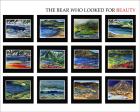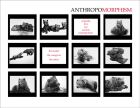|
I have worked on this exhibition since 1996. With the exception
of a few of the large canvases and the final production of the bear
track sculpture, all art was produced "in the field" at our Kambalnoe
Lake base camp.
The exhibition was created for viewing in the following order:
 "Into
the Deep" - a footprint sculpture of 6'x24' showing tracks of bears
of all ages. Final casting of the 36 tablets is in acid etched concrete.
The sculpture weighs 3,600 pounds - close to the combined weight
of two male Kamchaka Grizzlies. My painting of "Harlequin Bear"
is situated at the end of this corridor - a symbol of entry into
the world of the bear. "Into
the Deep" - a footprint sculpture of 6'x24' showing tracks of bears
of all ages. Final casting of the 36 tablets is in acid etched concrete.
The sculpture weighs 3,600 pounds - close to the combined weight
of two male Kamchaka Grizzlies. My painting of "Harlequin Bear"
is situated at the end of this corridor - a symbol of entry into
the world of the bear.
  "The
Bear Who Looked for Beauty" - a grid of 12 paintings. Charlie's
photo of a sitting bear looking across Kurilskoye Lake at the volcano
caused me to realize that bears pause to enjoy beauty. I located
many "nesting sites" (places dug out for a nap) strategically located
with incredible views of Kambalnoe Lake during the summers of 1996
through 1997. "The
Bear Who Looked for Beauty" - a grid of 12 paintings. Charlie's
photo of a sitting bear looking across Kurilskoye Lake at the volcano
caused me to realize that bears pause to enjoy beauty. I located
many "nesting sites" (places dug out for a nap) strategically located
with incredible views of Kambalnoe Lake during the summers of 1996
through 1997.
I sat in these spots, looking out at the bear's eye level and interpreted
the scene as a bear might do.
 "Anthropomorphism"
- a grid of 10 portraits of Chico, Biscuit and Rosie. I wish to
challenge the appropriateness of attributing human feelings to those
of an animal. After having experienced entry into the world of the
grizzly bear, I conclude that many of their feelings are similar
to ours. But perhaps bears are even more in touch with their emotions.
I have seen our cubs remember details of their life that affected
them emotionally a year after the event occurred. "Anthropomorphism"
- a grid of 10 portraits of Chico, Biscuit and Rosie. I wish to
challenge the appropriateness of attributing human feelings to those
of an animal. After having experienced entry into the world of the
grizzly bear, I conclude that many of their feelings are similar
to ours. But perhaps bears are even more in touch with their emotions.
I have seen our cubs remember details of their life that affected
them emotionally a year after the event occurred.
"Another Dimension" - a collection of paintings that are about
another dimension possible for humans to enter - call it the 4th
dimension; that of bears. It is an exciting world. Many times last
summer, after an euphoric day of walking out with Chico and Biscuit
I painted this world of the bear. It is a spiritual world, impossible
for me to intellectualize.
"Denning Site" - a drawing in sound called "If Bears Could Sing".
I taped the magical voices of our cubs communicating. Their vocalizations
are as haunting as those of whales. Not one growl is included -
too many negative associations and too predictable!
"In Situ" - a video that on one level is a "fuzzy bear story" about
Charlie and I raising our cubs and releasing them to the wild. On
another level it is about a sanctuary that perhaps can be left in
its place - in its original situation, as it was in the beginning.
Guest Curator: Ewa Sniatycka writes the following:
"Wilderness experiences have always been fundamental to Maureen
Enns' life and artistic practice. Issues surrounding wildlife management
and conservation have informed her work, and have taken her around
the world. Each of these journeys has resulted in a body of work
that distills Enns' experiences and memories through a variety of
media.
For almost a decade, Enns has focused her attention on the grizzly
bear. Her artistic research began in the backcountry of Banff National
Park and has led her to the southern tip of the Kamchatka Peninsula
in eastern Russia. Maureen Enns and her partner, writer Charles
Russell, have traveled to this remote landscape for the past four
years to study and live among bears. A vital component of the study
was the reintroduction of three orphaned grizzly cubs to the wild.
These young bears are the subjects of Enns' recent work.
Through the Eyes of the Bear is a reflection of Enns' relationship
with the cubs and her intimate understanding of their world. From
the moment of entry, the viewer is asked to walk (figuratively)
in the footsteps of Ursus Horribilis: the grizzly bear. In her work
Maureen juxtaposes realism and abstraction. Her paintings and mixed
media works translate interior landscapes and the world of the bear,
while intimate charcoal portraits of the cubs question the exclusivity
of "human" emotions. The video and sound installation in the Media
Gallery add further insight into Enns' personal journey.
The Interpretation Gallery, in the Enmax Education Center, presents
an auxiliary exhibition incorporating a variety of resource materials
that reference Enns' exhibition. A retrospective survey of Maureen's
work is juxtaposed with a variety of stories and myths that comprise
our cultural understanding of bears and the "wild". Various interactive
components invite viewer interaction and a Cyberspace Terminal encourages
the exploration of Enns' and Russell's web site documenting their
research in Kamchatka.
Through the Eyes of the Bear illustrates a personal and
artistic journey o the edge of civilization, challenges cultural
notions regarding the truth about the grizzly bear, and addresses
issues of conservation and management of the few remaining wild
places on the planet.
An exhibition catalogue has been produced including essays by
Maureen Enns and guest writer Dennis Slater."
|